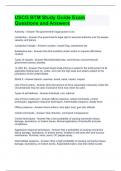USCG BTM Study Guide Exam Questions and Answers
Authority - Answer-The government's legal power to act
Jurisdiction - Answer-The government's legal right to exercise authority over it's people, vessels, and places
Jurisdiction triangle - Answer-Location, vessel/ flag, substantive law
Substantive law - Answer-One that prohibits certain action or requires affirmative conduct
Types of vessels - Answer-Recreational/private, commercial, noncommercial/ government owned, warship
14 USC 89 - Answer-The Coast Guard shall enforce or assist in the enforcement of all applicable federal laws on, under, and over the high seas and waters subject to the jurisdiction of the United States.
SEAS II - Answer-Search, examine, arrest, seize, inquire, inspect
Use of force policy - Answer-Only that amount of force reasonably necessary under the circumstances may be used. Excessive force may never be used.
Types of self defense - Answer-Individual, unit, national
Use of force continuum - Answer-Officer presence, verbal commands, control techniques, aggressive response techniques, intermediate weapons, deadly force
Officer presence - Answer-Good uniform, blue light, boat, gun belt, attitude
Verbal commands - Answer-Task direction, command/ consequence
Control techniques - Answer-Has a low probability of causing connective tissue damage, lacerations, or broken bones. Normal application of handcuffs and pain compliance.
Aggressive response techniques - Answer-Has a probability of causing connective tissue damage, lacerations, or broken bones. Irritation to the eyes skin and mucous membranes. Punches, kicks, stuns, OC pepper spray.
Intermediate weapons - Answer-Have a high probability of causing connective tissue damage, lacerations, or broken bones. Expandable baton, less than lethal rounds Deadly force - Answer-Force that is likely to cause death or serious physical injury. Disfigurement broken bones unconsciousness.
Four types of subjects - Answer-Passive compliant, passive resistor, active resistor, active aggressor
Passive compliant subject - Answer-Follows officers requests or verbal direction
Passive resistor - Answer-Does not follow officer is a request or verbal directions, but offers no physical resistance to the officers attempt to gain control
Active resistor - Answer-Does not follow officres request or verbal directions and offers physical resistance 2 the attempt to gain control but does not attempt to harm the officer
Active aggressor - Answer-Attempts to harm or attack the officer
LEAPS - Answer-Listen, empathize, ask, paraphrase, summarize
When is it appropriate to draw your weapon? - Answer-1. when deadly force is authorized. 2. When there is a reasonable possibility that the use of deadly force may be required
Pressure point techniques - Answer-Infra-orbital, hypoglossal, mandibular angle, c-
clamp, jugular notch
Upper body techniques - Answer-Front jab, straight punch, forearm strike, brachial stun,
suprascapular stun
Lower body techniques - Answer-Front snap kick, angle kick, superficial peronial, knee strike
Deadly force triangle - Answer-Weapon, opportunity, action of subject
Two prong test for opportunity - Answer-Unrestricted access and maximum effective range
Coast Guard policy concerning warning shots - Answer-Not authorized with PDW, allowed with approval in certain situations
Tactical questions - Answer-Without reaching for or grabbing, do you have any weapons on board? Have you been boarded by the Coast Guard this year? Where are you going? Did you catch anything today?
Custodial situation - Answer-Depends on whether a reasonable innocent person in the subject's position would feel a restraint on his or her freedom of movement to such an




